Ensuring that strategic projects and initiatives deliver as expected isn’t easy. It doesn’t help that there is often confusion regarding results and how they will be measured. Ending that confusion has to be a priority and here is the tool – called the results chain – that is needed.
Managing by Objectives
Management by objectives has been around for about 70 years, so you might expect that it had been perfected by now. However, that is often far from the case!
As managers we all know about SMART objectives, yet from time to time, organizations are not always clever when it comes to setting targets and tracking results.
As evidence, research tells us that most projects and strategies fail to deliver the results that are expected from them. All this suggests that it is time to review not just how results are being measured, but more fundamentally how they are being defined.
Too Much Confusion
The latest trend is a shift from Management by Objectives to ‘Results Based Management‘(1). But is that more than just a play on words? Well, when it comes to objectives and results, words matter a lot.
‘Something that happens as a consequence’ – that’s how results are defined by Dictionary.com. Unfortunately, defining results within organizations is a lot more complex.
Confusion starts with the terms used to describe the results of a project, strategy or anything else. For example, what is the difference between a goal, an objective and a result? There are quantitative and qualitative metrics as well as leading and lagging indicators. There are even different types of results ranging from outcomes to outputs. There are proxy results too.
The result of this confusion about results is a proliferation of metrics and KPi’s – some of which may even be contradictory even competing. Not surprisingly this can lead to confusion about how results should be measured and a mismatch of expectation regarding success. Thus, management by objectives often ends up being more an art than a science.
Bringing Clarity to Confusion
How to end the confusion surrounding objectives and results? Well, for inspiration we turned to an area where the challenges of measuring results and tracking success are greatest – that is the area of international aid projects.
There we find a recognition that not all results are created equal and a much more nuanced approach to measuring and tracking success.
Rather than there being a single type of result, there is a ‘chain of results’ – 5 different types of results and each serves a different purpose in measuring and communicating performance and success.

We are going to use these categories in terms of a project, but it could be any work stream, initiative or strategy, with the 5 categories of ‘results’ being:
| Project Inputs | The things we need to deliver the project (e.g. money, manpower and any other resources) |
| Project Activities | The things we do in delivering the project (e.g. steps, processes, work streams, etc.) |
| Project Outputs | What the project delivers / produces (e.g. new system or process) |
| Business Outcomes | The knock on business benefits (e.g. what the system or process enables the business to achieve over the short to medium term) |
| Business Impact | The longer term impact (as seen by stakeholders). |
This logical sequence is called the ‘chain of results’, with an example below(2):

The Results Chain Explored
Next let us explore each of the 5 links on the results chain next.
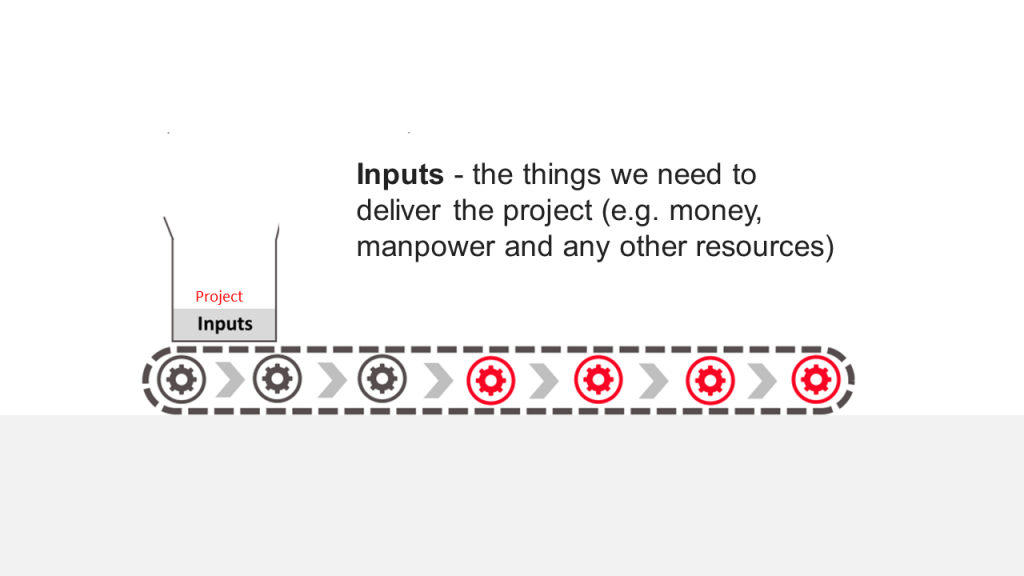
Level one of measuring, planning or tracking a project is to determine the resources or inputs required for success. That includes the manpower, raw material, assets or resources committed or utilized by a project or strategy. Examples of inputs might be:
- The number of developers or developer days for a software project
- The number of sales people or the quantity of sales leads for a sales team.
Metrics and measurement in respect of inputs and activities are important in resource allocation decisions – especially when resources are scarce. They tell you that it took Y time or resources to achieve the result and illuminate how economical the process is.
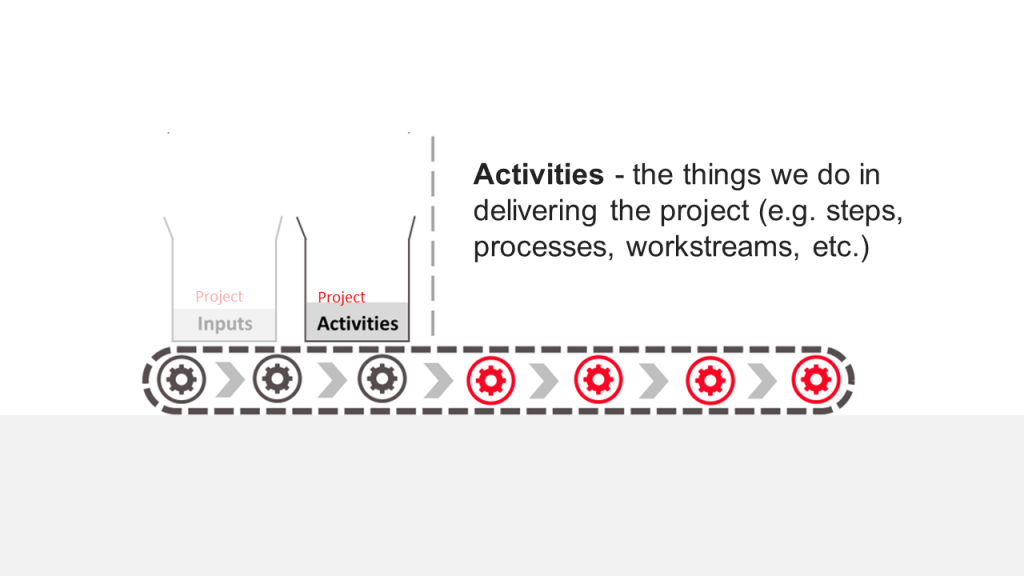
Metrics are ‘what we do (or must do)’ – the set for the activities involved in a project. That is the process, steps or work involved in achieving a particular result. It is a means of tracking what the project or initiative does. For example:
- The lines of code written or deployed by a software development team.
- The number of leads and presentations for a sales team (quantitative) or description of the conversion process (qualitative).
Generally, there is some assumption (implicit or explicit) regarding the link between activity and the desired end results. For example, a hypothesis or assumption regarding the conversion rate from sales lead or presentation to customer sale (based on historical patterns, industry norms or just hope).
Such an assumption enables the sales director to expect that Y customer presentations will generate X sales. In this way customer presentations become a proxy for the sales figure and the sales team has a very actionable target – 12 customer presentations per month per salesperson. That of course depends on presentations converting into sales at the expected rate. Spelling out underlying assumptions and uncertainties is key.
Input and activity metrics are important for transparency and inject realism into project goals – ‘ok if you want to achieve that project outcome here are the inputs and activities that are required – change the outcome then you must change the inputs and activities correspondingly’.
These metrics are important in measuring and tracking efficiency or pinpointing waste. For example, lines of code per day can be compared against industry standards, while conversation rates for leads can be tracked over time as a measure of efficiency in sales.
Activities and inputs are generally easily to measure and track. But they are not really results in the truest sense, but rather a proxy for them. Hence, they may be called ‘pseudo metrics.’
A senior executive is probably not going to be very interested in the activity metrics saying something like ‘lets cut to the chase – what is the sales number – the number of sales presentations doesn’t really interest me’.
Central to the challenge surrounding activity and input metrics is that they assume a clear and static cause and effect relationship between the input / activity and the result – something that is a challenge in complex environments. Consequently, these should be review continually.
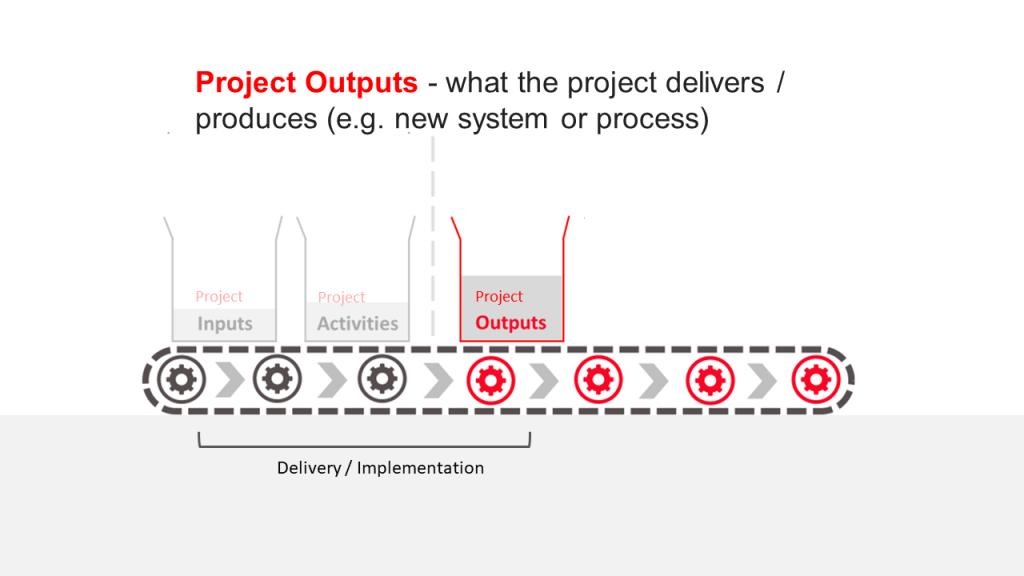
These are the project immediate outputs or deliverables that can be directly tied to the project or strategy. This is the first real category of results.
For our sales team the output may be a certain value of sales pipeline or order book, or the release of a particular software update for our software team. These are the immediate deliverables that the organization has to show for the work of the project and team.
If the earlier metrics are about economics and efficiency, output-related metrics measure and track effectiveness. They answer the questions:
- Did we do it? Did we deliver what was expected?
- Did we deliver the software release or meet the sales target?
- Did we do these things to the standard expected and to schedule?
Being clear on the outputs of a project is essential. However, a focus on inputs and outputs explains what a project or strategy delivers but may tell little of business outcomes or impact. That is a constant complaint of business leaders – the challenge of connecting projects and strategies (in areas ranging from technology to marketing) to business needs and priorities.
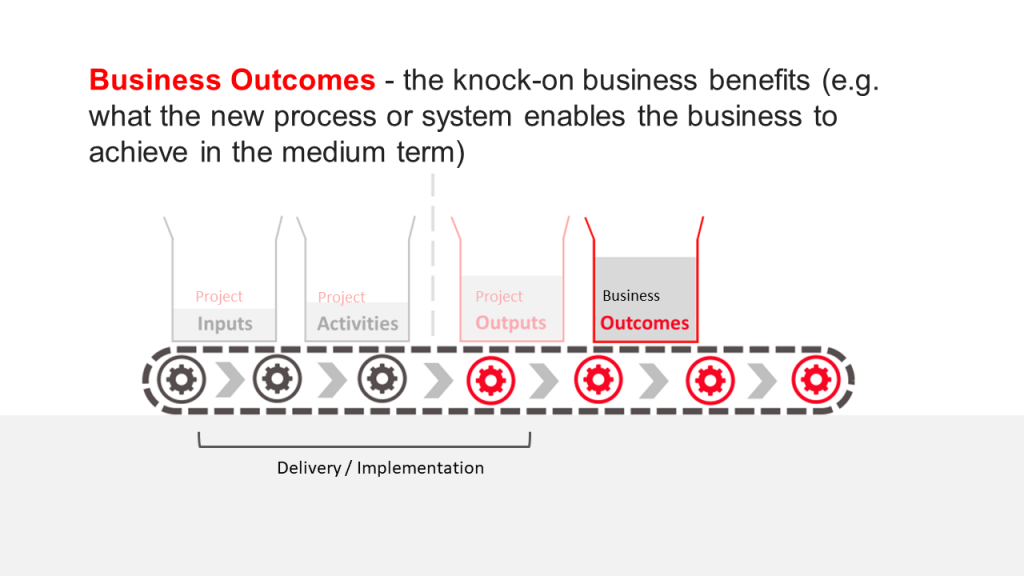
In tracking business outcomes we are getting closer to the ultimate ‘why?’ of the project or initiative and what it aimed to achieve.
The project may have delivered a new IT system, but that system is not the end in itself, rather it is what the organization can achieve as a result of it (e.g. lower operating costs, greater output, business continuity, etc.) in the short to medium term.
For example, looking back at the 12 months since the release of the software, the range of outcomes might include:
- A 5% reduction in customer churn and customer helpline support requests down (both resulting from a better user experience).
- A boost to marketing conversation rates due to the appeal of new features and functions as well as high-profile industry awards.
- Higher rates of staff retention because the updated product feature roadmap has excited the development team.
A bigger picture view of the outcomes, at year-end, for our sales team might include:
- Growth in market share by 3%, with sales revenues up by 20 percent and profits up by 5% (pushing for growth has damaged margins).
- Average order wait times has risen to 21 days. Increased pressure on operations to meet demand and the implementation of new sales and operations planning methods.
- The demand for more and better campaigns to fill the top end of the pipeline led to a rise in tension between sales and marketing. Key personnel changes resulted.
The failure to clearly link project outputs to business outcomes is one of the principle complaints levelled at project managers. A key reason this happens is because the process by which projects are prioritized does not fully clarify business needs, outcomes and results.
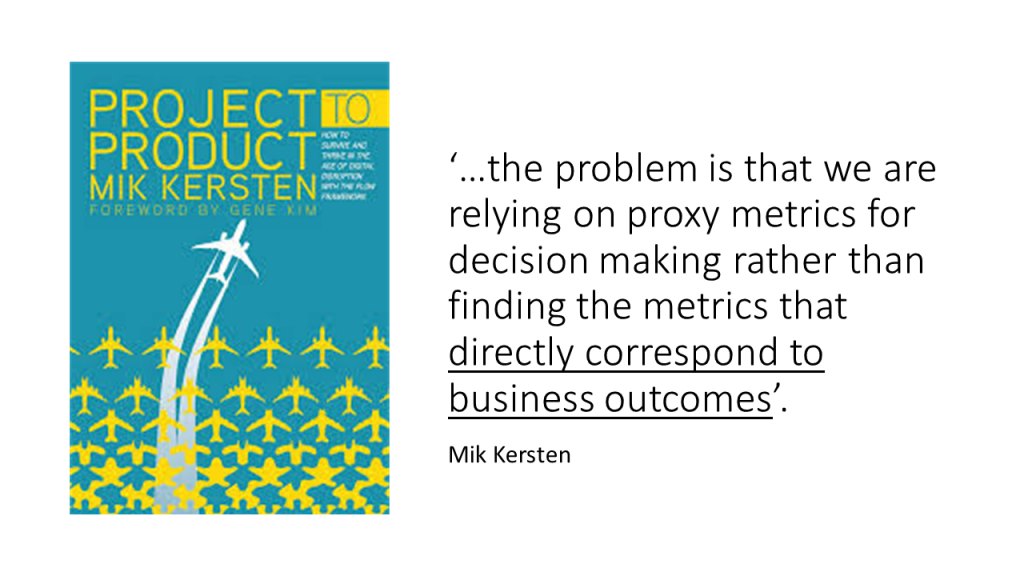
When business outcomes are not linked to project outputs, organizations end up with projects that deliver as expected but fail to clearly address business needs and priorities.
The project ends up delivering the new IT system, or HR process, but leaves business leaders struggling to clearly articulate how these have helped the business to succeed. Specifically, why is the business better as a result.
In an age where projects and initiatives must compete for limited corporate resources, those with the most compelling business outcomes will win. So, project sponsors must get better at communicating business outcomes.
Linking projects and strategies to business outcomes requires a process of effective and ongoing stakeholder dialogue. This centres on understanding and addressing the needs of key stakeholders (e.g. Why does the CEO want the new system? Why does compliance want it? What will it do for operations, etc.).
Linking project outputs to business outcomes is difficult because there may be any number of dependencies involved in translating project deliverables into the desired business outcomes. Moreover, many of these may be outside the control of the project team. A critical set of dependencies often relates to the requirement of a change of behaviourr or culture within the organization.
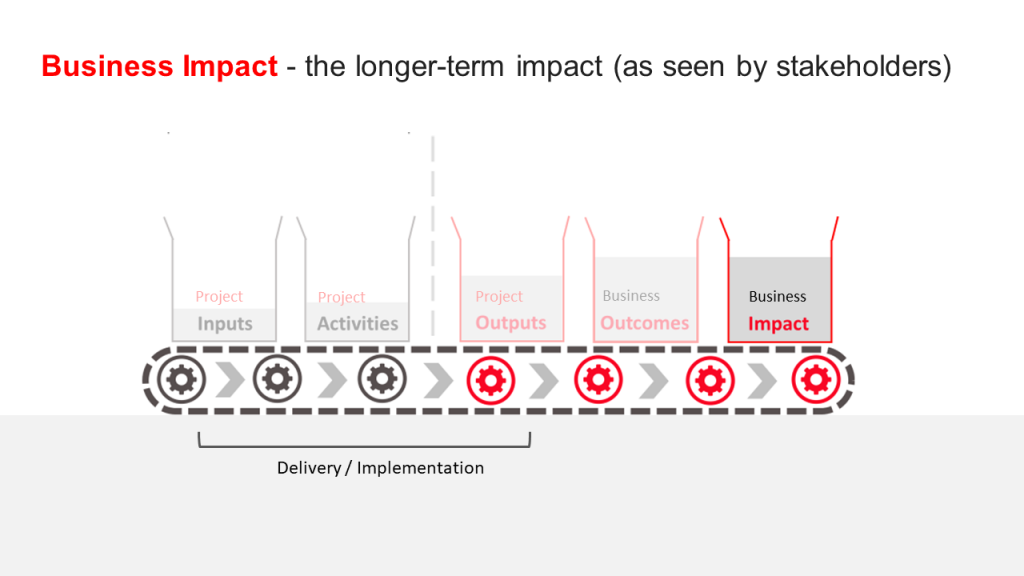
Business Impact is the holy grail and ultimate measure of project success. This involves key stakeholders and stakeholder groups answering the question:
- What has been (or will be) the impact of the project or strategy?
- What is (or will be) different as a result?
Exploring the business impact of a project or initiative is about a ‘bigger picture’ longer-term view of success, including knock-on and downstream implications.
Business impact is the stuff of the C-suite, but it is not easy to either predict, manage or forecast. For new projects clearly communicating the business impact of new projects or initiatives is a key challenge facing many executives. Some of this stems from the practical challenges in building the business case, as well as the difficulty in engaging others in a compelling vision of a better future.
Talking about business impact relies heavily on assumptions and scenarios. That is because, in a complex world, cause and effect are not always clear. With many projects and initiatives it begins with a hypothesis regarding business value that stakeholders can believe in/aspire to.
Communicating the benefits realized by a project isn’t easy either. Leaders need to take care not to damage credibility in what they take credit for achieving and yet must not shy away from the limelight.
Here is an assessment of business impact for our two example projects, starting with the software organization:
- The software release was a key step in the realization of the product vision and a ‘game changer’ in attracting industry awards, channel partners and potential suitors/investors.
- It also enabled the organization to attract a high-profile Chairman.
- Within 2-3 years, the CEO will reflect on the success of that particular software release as changing the trajectory of the business.
For the sales organization, the drive to grow sales marked the beginning of a new chapter:
- It has seen a doubling of sales within 3 years and provided the financial resources to invest in technology and new product development.
- It shone the spotlight on sales and marketing, causing it to ‘raise its game’ and to ‘make others sit up and take notice’.
- Investment in these areas has grown significantly, with new talent and the latest tools and systems to support the organization’s growth ambitions.
- This includes a revamp of the marketing department and the establishment of an in-house online marketing team that has grown web traffic by a factor of 5 and web generated leads by a factor of 3.
Why Use the Results Chain?
We need to use a range of measures to track the performance of complex projects and strategies. Keeping our motivation (and our sanity) often requires being able to see progress (against input and activity goals) even when results may be off in the distance. The chain of results is about progress and performance as well as success or results.
In exploring results, we must work in both directions:
✓ From left to right – encourages those who are tied up in delivery to look beyond activities and outputs to business impact
✓ From right to left – encouraging those who are focused on business results to link them back to inputs (resources) and activities – injecting new transparency and realism.
Consider the timeline – looking to the right encourages managers to look beyond the short term and to connect their projects to the desired future of their stakeholders. Looking to the left encourages visionary leaders to work back from their future vision to those activities requires for its success.
Use the ‘results chain’ to engage various stakeholders in the conversation regarding results. Involve them in creating the hypothesis of business value and get them to take ownership of it. Use it to link your project to their vision of future success. In this way the chain of results can help ensure not just that projects are delivered on time and to budget, but that they meet the needs of stakeholders and the business.
Be more explicit about assumptions, uncertainties and risks at each stage of the ‘results chain’. Call them out. Design experiments to test / illuminate them. This is particularly important with new or complex activities where the results are uncertain, and we must ‘learn as we go’. It also means that a ‘results chain’ needs to be reviewed and updated continually.
Improve decision-making, being more explicit about the results required from projects and more precise in how they are measured. Provides a framework to demonstrate project logic(1) and to ensure the consistency of the various metrics being used to track performance and success.
Notes:
(1) UN definition of Results Based Management: “RBM is a participatory and team-based management approach to programme planning that focuses on performance and achieving results and impacts. It is designed to improve programme delivery and strengthen management effectiveness, efficiency and accountability.” Source: UNESCO
(2) The Chain of Results is also called the Logical Framework Approach – a Results Based Management tool for systematic planning, implementing, monitoring and evaluating projects and initiatives.
John Murphy
Email Us



